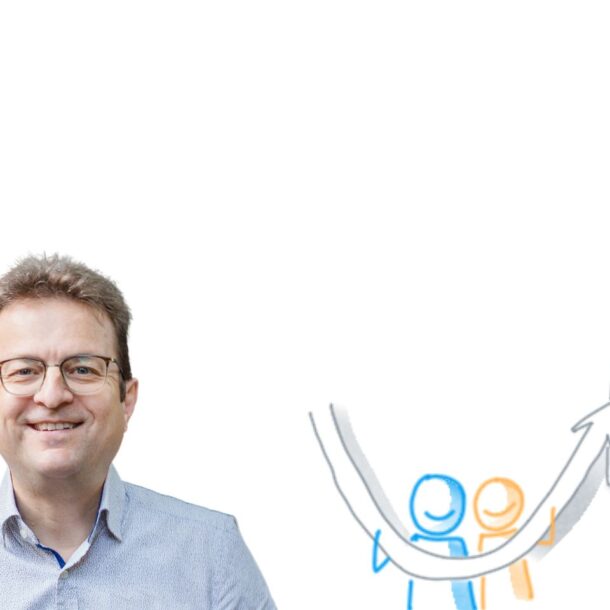
Change happens – Mindset shifts
A ping pong blog exploration of the overused term “mindset” between
Franzi
& Felix
Mindset is a term that people use very often nowadays. Especially in the context of the future of work and organizational development. But what does it mean? What is “the right” mindset? How does a mindset impact your personality, how you interact with others, how is it connected to how you show up and behave at your workplace, and what does it do with your organizational culture? I’m asking myself those questions and would like to explore them further with my lovely colleague Felix.
When Felix asked me some time ago what our topic could be to write about, “mindset” was one of my first thoughts. At work, we talk a lot about growth mindset, mindset change for a successful future or the need to develop an agile and more innovative mindset. But unfortunately, we use the term not intentionally but also underestimate its complexity.
Mindset – filled with expectations
So now, here I am. I am exploring the topic of “mindset”. Now it’s pretty challenging to start writing about it. Why? Because even though there are several definitions of different types of mindsets, like growth mindset, fixed mindset or agile mindset, out there, I still need help describing what mindset means for me. I even caught myself saying to a colleague last week, “can we please reschedule our call? I’m not in the right mindset today”. It seems so easy to talk about mindset, but we must think intentionally about what it means. Take my example; when I reflect on it, I feel that I could not be present, stay focused and be open to exchanging ideas in a non-judgmental way.
Mindset – scientific definition
Yes, we need to pay more attention to the complexity of mindset. Let’s explore mindset from the angle of transformation. According to the Oxford Dictionary, mindset is an “established set of attitudes, especially regarded as typical of particular group’s social or cultural values; the outlook, philosophy, or values of a person; (now also more generally) frame of mind, attitude, disposition.”
Mindset – a connotation
So, how would I describe my mindset, e.g. towards “change”? Describing is making it real, so becoming explicit about what you believe, how you generalize, what you ignore, or the group values you follow. I accept that life is changing. Change is connected to ups and downs. It’s ok if the first reaction to change is resistance. However, I want people impacted by a change to be involved. Change is vital to growing as a person, a group or a society. Our society and way of life need to be transformed at many levels to reduce the impact of climate change and inequality. I tend not to support the opinion of people who think “everything was better before”. And you, Franzi, what is your mindset regarding “change”?
Change stands for opportunities, exploring the unknown, and seeing things from a different perspective, but it also leads to uncertainty, fear, self-doubts and feeling of losing control. I associate change with high self-responsibility and the ability to cope with an emotional roller-coaster. Finding your way to balance the emotions and expectations that come with change is crucial. A growth mindset is needed to cope with change. But I’m not in the position to decide what mindset change is required as, in the end, it’s your connotation that provides the direction.
A programmed mental model?
Is it possible to change the mindset? What about listening to Dave Snowden, a specialist in complexity and sense-making? In his talk “Is Mindset Yet Another Agile Buzzword?” he outlines that terms like “agile mindset” imply that the mind can be programmed, i.e. we define a mental model and install it in our people, done! As a consequence: If “agile” fails in the organization, then we blame the people with the “wrong” mindset instead of the way “agile” was introduced. However, our minds are not computers and do not operate with simple linear cause-and-effect models.
Our minds are part of complex systems
Dave Snowden highlights three scientific facts:
1. People are intentionally blind: you do not see what you do not expect to see. The critical thing in decision-making is what stimulus you give people and what memories it triggers. What is known as mindset is an activated set of patterns in individuals. Snowden refers to a famous experiment, “Why Even Radiologists Can Miss A Gorilla Hiding In Plain Sight“.
2. People don’t make decisions in isolation from other people: how they connect and whom they connect with is far more important than who they are. Storytelling plays an essential role. Stories frame the way people see the world. Collective patterns are built on experiences and stories in the organization’s informal networks. Hence, the vital role of coffee corners and communities of practice in organizations.
3. Brain is not the sole repository of consciousness: consciousness is distributed across the brain, the body and social interactions. This insight resonates well with my experience as a co-active coach, where we see clients as a whole, including mind, heart, body, and social network.
According to Dave Snowden, mental models have no valid natural science basis; mindset is “a complete and utter scientific nonsense”. The incredible popularity of “mindset” is undoubtedly based on Carol Dweck’s theory of growth mindset and her bestseller book “Mindset – The New Psychology of Success “, even if scientists were not able to replicate her studies (source).
Mindset – a way to escape from self-responsibility?
So now what? If the term “mindset” is actually “nonsense”, why do we constantly talk about it or often use the term in the context of organizational development and learning? I noticed that mindset is often seen as a challenge whenever “change” is involved: reorganizations, changes of processes, frameworks, or even learning offerings. Sometimes it’s easier to say that a certain mindset or even mindset change is required in order to be successful than invest time to find out what people need or what the root cause of the problem is. By doing that, I’m wondering if we do not pull ourselves out of the responsibility as we say we do have this high dependency on mindset change by others, and in the end, we do not need to change but others?
I do not have an answer yet, but I’ve experienced many situations at work where projects “failed” because of a lack of willingness by others to change their mindset or, as Snowden would say, the failure is because our mind cannot be programmed. Now when I think about that, I also see a pattern. As highlighted at the beginning, we do not use the term intentionally nor reflect on what is truly behind a mindset change or shift.
What leads to a mindset shift?
While we took time to explore mindset from different perspectives, exchanged ideas and listened to the thoughts of each other, we noticed that we might need to view mindset more from the angle of “shifting” rather than “changing”.
Before our mindset can shift, we must become self-aware of our inner resources, values, beliefs, and attitudes that shape our behavior.
Hence, self-reflection and a high level of self-awareness is undoubtedly a key to a mindset shift. Therefore, I take, e.g. time for journaling most mornings. Writing what comes to my mind and answering self-reflection questions helps me identify points I was unaware of and notice shifts in attitudes.
Working with a coach offers opportunities to challenge existing thought patterns and behaviors, become self-aware of inner resources, values and beliefs, get clarity by exploring new perspectives, or address what someone can’t be with and tends to avoid.
Based on what Snowden outlined, interaction with others exposes us to new perspectives and ways of thinking, which can influence our mindset. Therefore, the importance of meet-ups and communities spanning across organizations. The interaction with the Corporate Learning community has led me to more openness to share.
Exposure to new experiences is another factor that can cause us to shift our mindset. For example, gaining new knowledge or going through personal experiences that challenge our beliefs can cause us to reevaluate our mindset.
In summary, the more we have explored mindset, the more we became aware that we “don’t know” what mindset is. Each of us defines “mindset” in our way and has its connotations towards its meaning. What became evident is that self-awareness is the foundation for shifting the mindset. The key to this shift lies in the attitude towards change, the values you want to honour with the shift and the impact you would like to create.
Reflection on the duet blogging experience
It has been a very eye-opening experience to use a ping-pong method to explore mindset and change. New ideas sparked when I read Felix’s thoughts, and I often caught myself saying, “that’s very interesting, never looked at it from this view or that’s new to me”. So it has also been a peer learning experience for me.
However, it has been challenging to find the right words to transition into a new paragraph or build on what has been said by the other before. Thus, it has been beneficial to have check-ins from time to time, talk about what each of us wrote, and support us in finding sentences we can connect with. Sometimes we even moved sentences around or combined our thoughts.
Thank you, Felix, for your trust and openness and for giving me the space and time to explore duet blogging with you. Very much appreciated!
But how was it for you? Anything you would do differently next time?
“Ping pong” writing opens up the space for both contributors to build on the content of the other. Again, the outcome of this duet blogging experiment is much more than the blog post. It’s about deepening a relationship and building on the different perspectives: 1+1 = 3. The one thing I’d do differently next time is to try a variant to create a ping pong blog post with a time box of one hour. Great that we have the opportunity to share many common interests, Franzi!
#mindset #change #peerlearning #cocreation #duetblogging
Address
Felix Harling

